My best lemon macarons feature lemon curd and tangy lemon buttercream sandwiched between two tasty macaron shells. They are light, refreshing, and completely irresistible. Even if you've never made macarons before, this recipe is completely beginner-friendly.
If you love macarons, check out my post on macaron flavors like my fantastic s'mores macarons for more sweet ideas. Or try my lemon almond cookies for an easy treat.
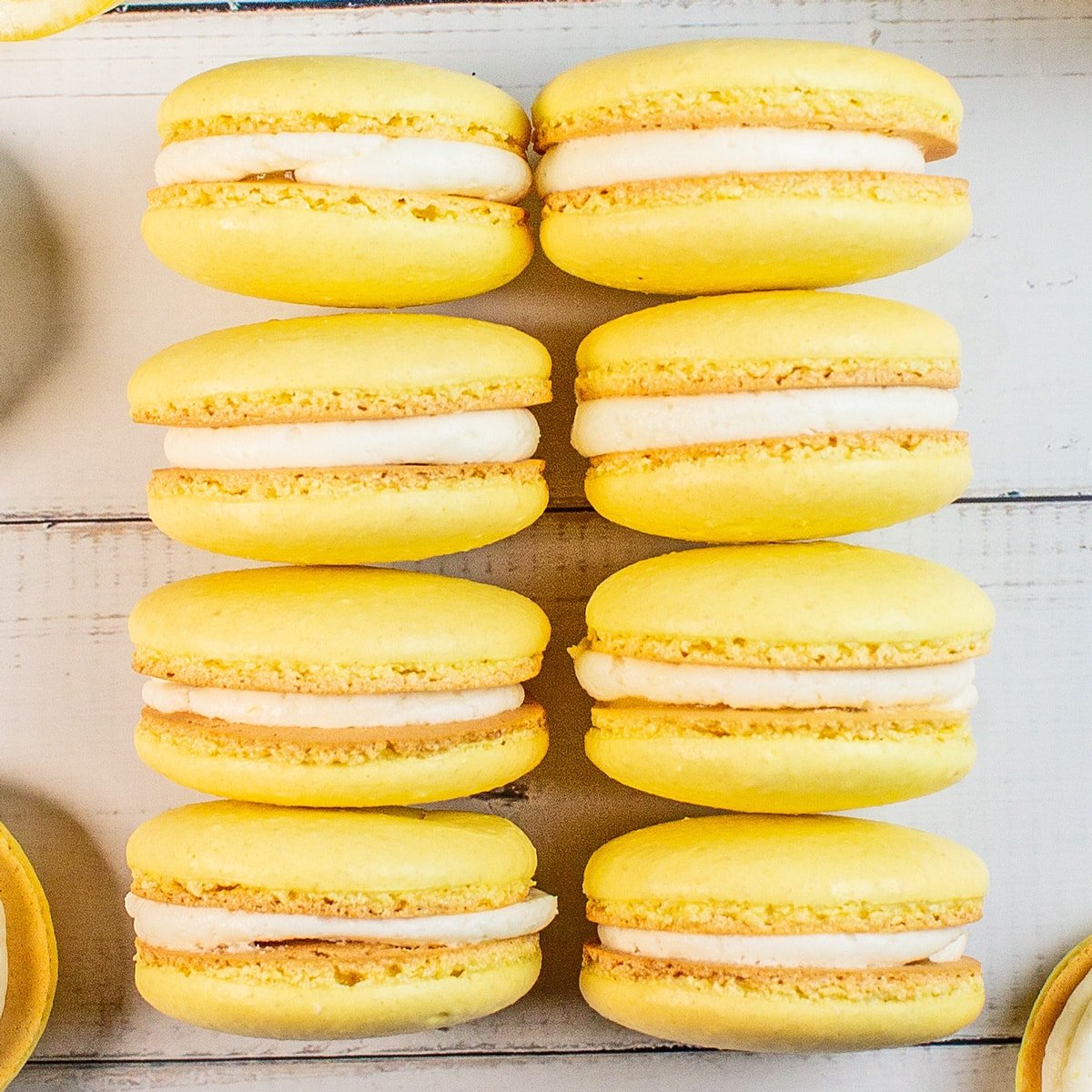
Jump to:
I've been dabbling around in the art of making macarons for decades and have learned a few things. These lemon macarons are one of my favorite flavors, as they're loaded with both lemon buttercream and my easy microwave lemon curd.
If you want to keep things extra simple, you can just use a filling of lemon buttercream (but I recommend adding the curd!) or try my lemon cream cheese frosting. And, if you've never made macarons before, this step-by-step recipe is great for a macaron beginner.
🥘 Ingredients

Macarons
- Almond Flour - Almond flour is the key ingredient in macarons and cannot be substituted for any other variety of flour. Make sure you grab almond flour and not almond meal!
- Powdered Sugar - Confectioner's sugar adds both sweetness and helps to achieve the perfect texture.
- Egg Whites - Whipped egg whites will create meringue that will be folded into the dry ingredients.
- Cream of Tartar - A small amount of cream of tartar helps to stabilize the meringue.
- Sugar - Standard, granulated sugar adds just enough sweetness.
- Yellow Gel Coloring (optional) - To make your macaron shells nice and vibrant, you can add some yellow gel food coloring. Do not use liquid food coloring, as it will interfere with the batter.
- Lemon Extract (optional) - These are standard macaron shells. If you want to pack some serious lemon flavor, you can also add a small amount of lemon extract (not lemon juice) so that the shells are flavored, too.
Do I Have To Weigh My Ingredients?
While I would normally say no, I do strongly recommend weighing your ingredients when making macarons. You will get the most accurate results.
Honestly, I find it easier to use a simple kitchen scale than to mess around with measuring cups and spoons.
However, if you don't want to weigh them, I went ahead and measured them out for you.
- 1¼ cup + 2 teaspoon almond flour
- 1¼ cup + 1 teaspoon confectioner's sugar
- ⅓ cup + 1 teaspoon sugar
- 3-4 large egg whites (sometimes I need exactly 3 egg whites, sometimes I need just a little more, depending on the eggs)
- ¼ teaspoon cream of tartar


Lemon Curd (optional, left photo)
- Sugar - Regular granulated sugar sweetens the curd.
- Eggs - Eggs help to thicken the curd into a smooth, rich consistency.
- Butter - Melted butter adds liquid and flavor.
- Lemon Juice - You can use bottled or freshly squeezed lemon juice.
- Lemon Zest - While you can leave this out, I recommend adding it for the best flavor.
*To make this lemon curd, I simply halved my microwave lemon curd recipe! Take a look at that post if you need more information.
Lemon Buttercream (right photo)
- Butter - You can't make buttercream without some room-temperature butter.
- Powdered Sugar - Powdered sugar adds sweetness and thickens the frosting.
- Lemon Juice & Zest - To make this buttercream lemon-flavored, we will be adding both lemon juice and zest.
- Heavy Cream (optional) - If you find that your buttercream is too thick, you can thin it out with a small amount of heavy cream (or more lemon juice).
Be sure to see the free printable recipe card below for ingredients, exact amounts & instructions with tips!
🔪 How To Make Lemon Macarons
Macarons are a very technical dessert to make, but this doesn't mean they have to be difficult. You will need a kitchen scale, some glass or metal mixing bowls, a hand mixer or stand mixer, a baking sheet, and your measuring utensils.
This recipe will make 40 macaron shells or 20 fully assembled macarons.
Make the Lemon Curd (optional)
Step 1: Whisk. In a medium-sized mixing bowl, thoroughly whisk together 1½ large eggs (*see note on halving eggs) and ½ cup (100 grams) of sugar until well combined (photo 1).
Step 2: Mix. Add ¼ cup (57 grams) of melted butter, ½ cup (118 milliliters) of lemon juice, and lemon zest and whisk until combined (photo 2).

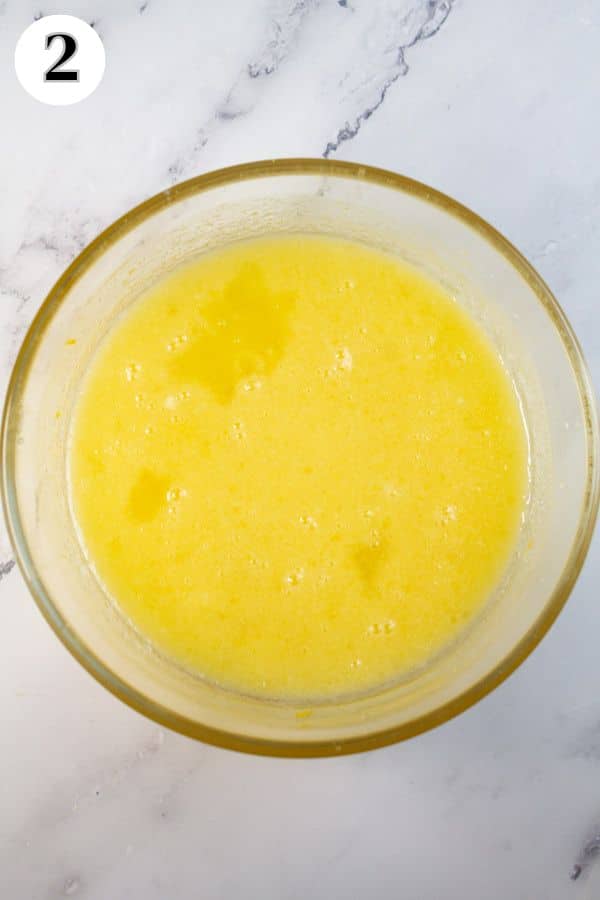

Step 3: Microwave. Microwave the lemon curd mixture in 30-second increments, stirring well with a spoon in between each one. This will take several minutes. You'll know it is ready when you can see the stirring tracks in the curd, and it sticks to the back of your spoon (photo 3).
Step 4: Chill. Set the lemon curd in the fridge to chill while you prepare the macarons.
Make the Macaron Batter
Step 5: Pulse. Add 125 grams (1¼ cup + 2 teaspoons) of almond flour and 125 grams (1¼ cup + 1 teaspoon) of confectioners sugar to your food processor and blend until the mixture is extra fine (photo 4).

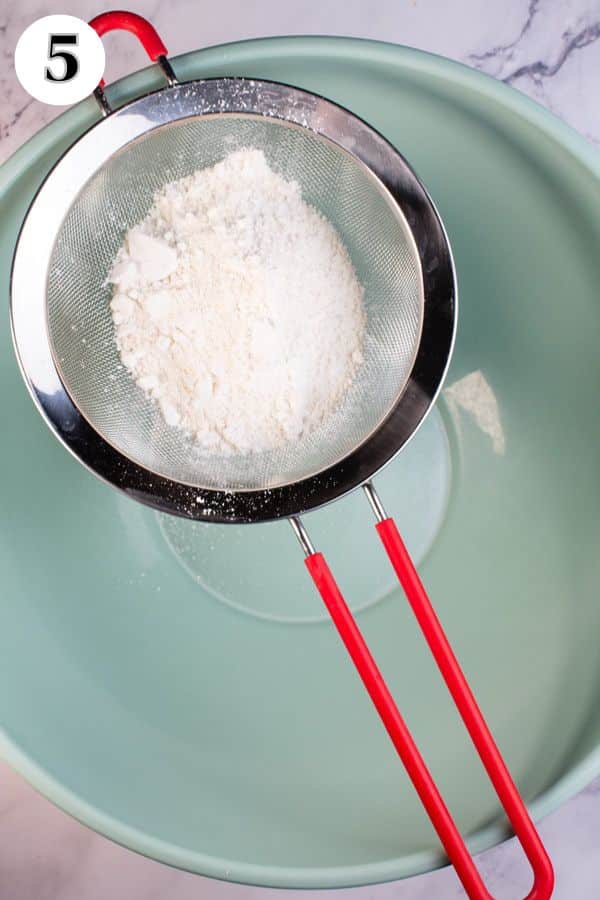
Step 6: Sift. Use a sieve to sift the almond flour mixture into a large mixing bowl, using a spoon to break up any chunks (photo 5). There may be some larger almond pieces left over at the end, but try to discard as little as possible.
Step 7: Begin the meringue. In a metal or glass bowl, use a hand mixer or stand mixer with the whisk attachment to beat 100 grams of egg whites (3-4 large egg whites), ¼ teaspoon of cream of tartar, and the optional ½ teaspoon of lemon extract (photo 6) on medium speed. The eggs will be foamy (photo 7) and then will reach soft peaks.


Step 8: Add sugar. Once you have soft peaks, slowly mix in 80 grams (⅓ cup + 1 teaspoon) of sugar on medium speed until well combined.
Step 9: Color the meringue. Continue to beat the meringue at medium-high speed until medium peaks have formed. Then, you can add the optional yellow gel food coloring (photo 8) and continue to beat until you have stiff peaks (photo 9).


Step 10: Begin combining. Slowly fold ⅓ of the meringue (photo 10) into your flour mixture until combined.

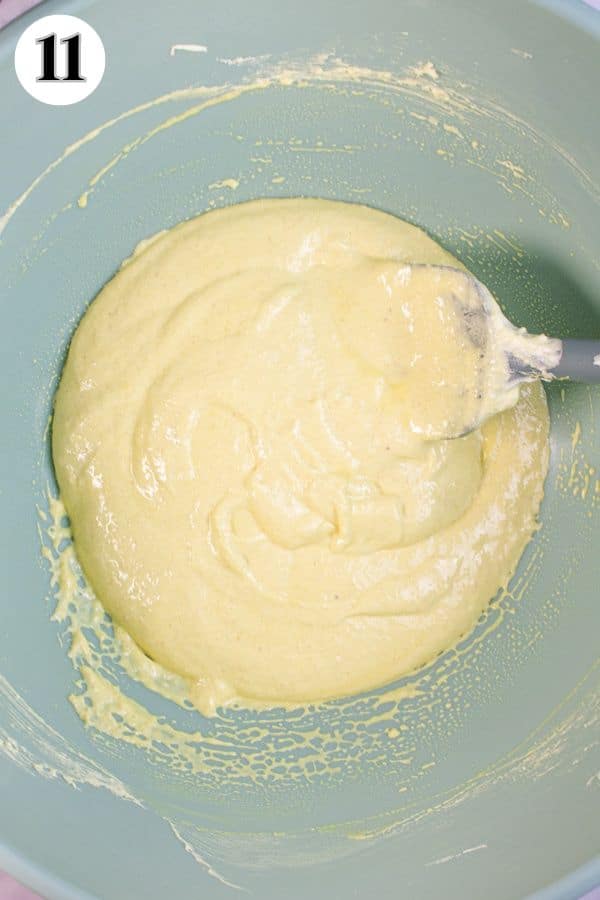
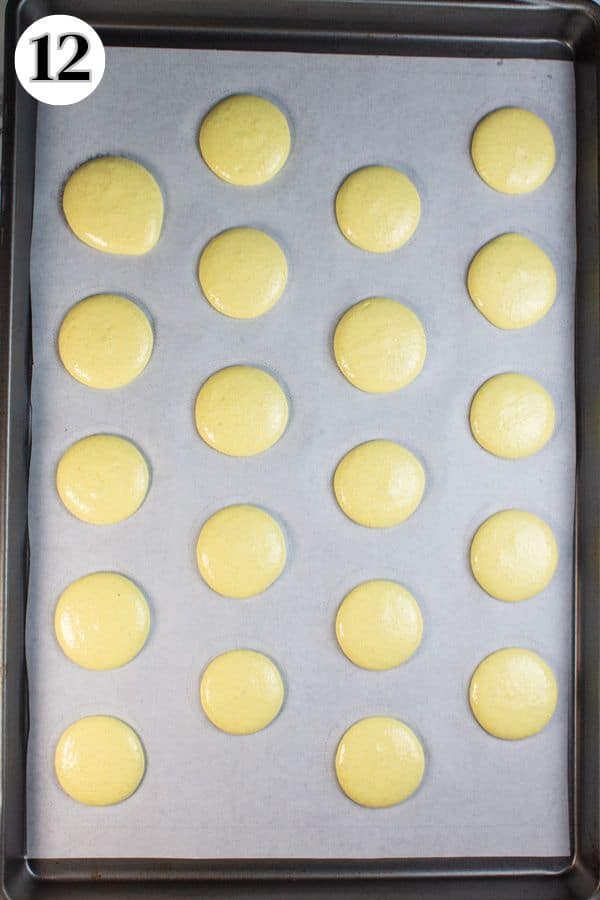
Step 11: Repeat. Repeat this process with the remaining ⅔ of the egg whites, only adding ⅓ at a time, and gently folding in between each addition (photo 11).
Step 12: Continue folding. After the meringue has been thoroughly added, continue to gently and slowly fold the macaron batter until the batter falls from the spatula in ribbons. *The consistency should be similar to honey or lava. If you let the batter fall from your spatula, it should only take about 10 seconds to sink back into itself.
Pipe the Macarons
Step 13: Transfer. Once you have reached the perfect consistency, transfer the batter into a piping bag that has been fitted with a round tip (or a storage bag with the corner cut off).
Step 14: Prepare. Place parchment paper or a macaron mat onto your baking sheet.
Step 15: Pipe. Pipe the macarons onto your parchment paper (or mat) in 1½-inch circles, making sure to space them at least ½-inch apart from each other (photo 12).
Step 16: Remove air bubbles. Firmly tap the baking sheet on the counter 5 times to get rid of any air bubbles. Then, use a toothpick to pop any remaining bubbles that you might see.
Step 17: Rest. Allow the macarons to rest on the counter at room temperature for 30-60 minutes or until they are dry to the touch and no longer tacky. Don't let them continue to rest past this point.
Step 18: Preheat. While the macarons are resting, go ahead and preheat your oven to 325˚F (160˚C/Gas Mark 3).
Step 19: Bake. Once ready, bake the macarons for 10-13 minutes, or until the macarons don’t move if you tap on them slightly (they should be only just starting to brown).
Step 20: Cool. Remove the macarons from the oven and let them cool on the baking sheet for 10 minutes before moving them to a wire rack to finish cooling.
Make the Lemon Buttercream
Step 21: Beat the butter. In a large mixing bowl, add ½ cup (113.5 grams) of butter. Use a hand mixer or stand mixer to beat it for 1 minute until the butter has become light and fluffy.
Step 22: Add sugar. Add 1¼ cups (150 grams) of confectioner's sugar (photo 13) and beat until combined.


Step 23: Finish. Add 1¼ tablespoons of lemon juice and 1 teaspoon of lemon (photo 14) zest and beat on medium-high speed until smooth (photo 15). If your frosting is too thick, you can adjust it by adding small amounts of heavy cream (or more lemon juice).
Assemble the Macarons
Step 24: Prepare the buttercream. Scoop the buttercream into a piping bag with a round tip (or a storage bag with the corner cut off).
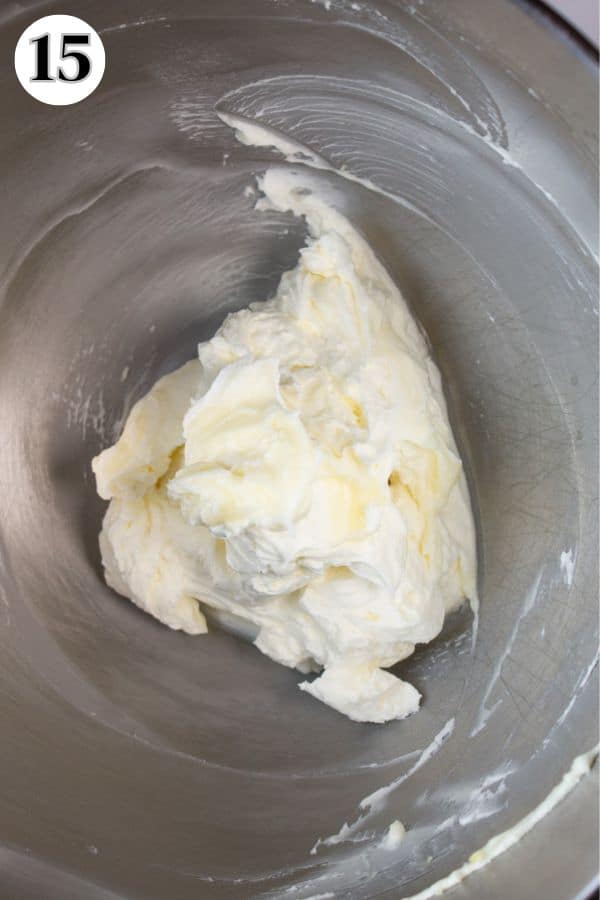

Step 25: Pipe. Take one of your cooled macaron shells and pipe a ring of lemon buttercream around the outer edge.
Step 26: Add lemon curd. Scoop or pipe some of the chilled lemon curd into the space in the center of the macaron shell (photo 16).
Step 27: Assemble. Gently press another macaron shell on top to form a sandwich.
Step 28: Serve or chill. For best results, place the macarons into an airtight container in the fridge for 24 hours. Then, allow the lemon macarons to come up to room temperature and serve.
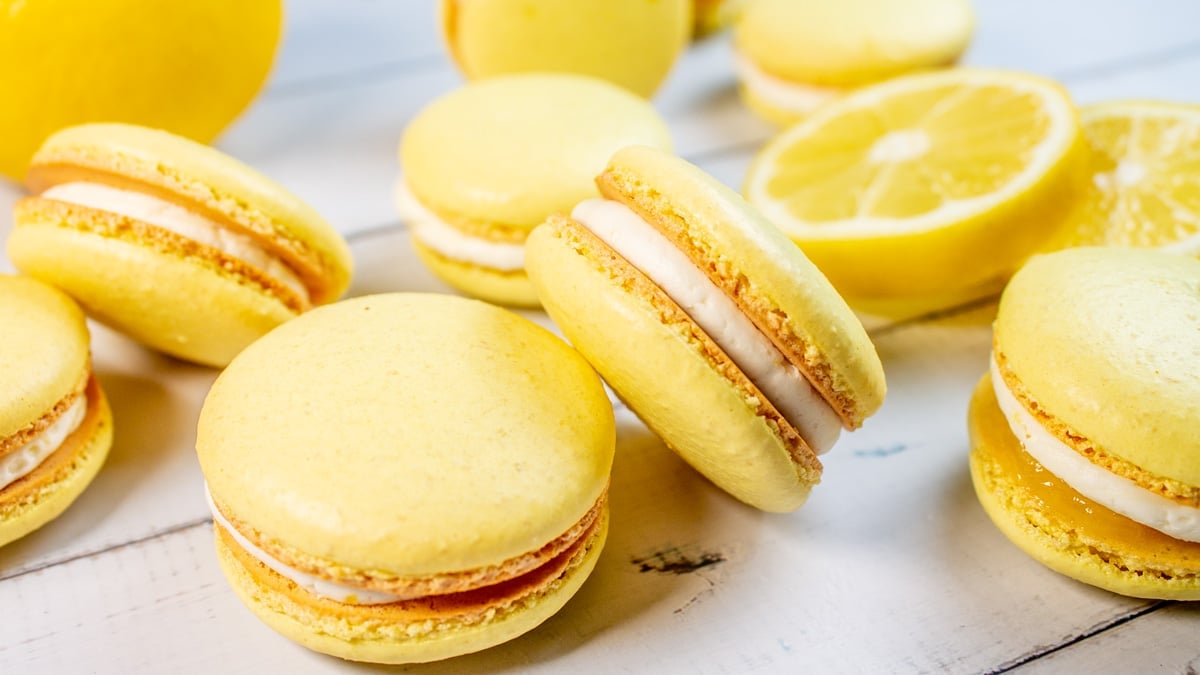
>>>See All Of My Tasty Recipes Here!<<<
💭 Angela's Pro Tips & Recipe Notes
- Measure your eggs. To halve an egg, crack it into a bowl and whisk it thoroughly. Then, scoop out about half of it to use.
- Try a piping tip. I recommend using a large, round piping tip for both the macarons and the buttercream. I used a Wilton 12 tip, but a storage bag with the tip cut-off will work, too.
- Use a template. You can buy silicone macaron baking mats to help keep all of your macaron shells consistent in size. If you don't have one, you could also buy parchment paper with the template printed on it (which is what I used), print a template off online, or trace circles onto the back of your parchment paper.
- Sift your ingredients. Don't skip out on sifting your ingredients. This is what helps to achieve the perfect texture.
- Find the right consistency. Make sure you don't overmix your batter, as it will cause your macarons to flatten out. The consistency should be thin enough to let the batter fall from your spatula in figure 8, and it should sink back into itself within about 10 seconds. If it is faster than this, you have overmixed it. If it is slower than this, keep folding to thin it out some more.
- Pop the air bubbles. Air bubbles will cause your macarons to crack. After piping them, firmly bang the baking sheet onto the counter to pop the air bubbles. Then, use a toothpick to pop any that you can still see.
How Do I Know When My Meringue Is Ready?
You'll know your meringue is ready to go when it has stiff peaks. This means that the egg whites are glossy and smooth, and when you pull the whisk out of the meringue, it will have a peak that points up and doesn't droop down.
If the peaks are still drooping, they need to be mixed longer. However, you can also overmix your meringue, which causes it to become too thick and break.
Do I Have To Let My Macarons Rest?
Yes! This resting period is crucial to making macarons.
Letting your macarons rest will help them to develop their feet so they will rise upwards instead of outwards.
During this time, your macaron batter will develop a "skin," which is what causes it to lose its shininess and tacky texture. This is how you know they are ready to bake.
Humidity can greatly affect how long this will take. It could be as little as 30 minutes or as long as an hour or more.

Looking For More Macaron Resources?
See the complete beginner's guide to making macarons for starting your journey to macaron mastery. Or get help with the baking process in my troubleshooting macarons article.
🥡 Storing
Place shells into an airtight container and refrigerate for up to 6 days. Simply add your filling when you are ready.
If assembled, place your lemon macarons into the fridge in an airtight container for up to 4 days.
Freezing
Once the shells have fully cooled, place them into an airtight storage container and freeze them. When ready, allow them to thaw in the fridge for a few hours before filling and assembling them.
You can also freeze assembled macarons. Allow your macarons to fully bloom in the fridge for 24 hours before freezing them.
Stack your macarons carefully in an airtight container and place them in the freezer. When you're ready to serve the macaron cookies, allow them to thaw in the fridge for a few hours.
Do you love a recipe you tried? Please leave a 5-star 🌟rating in the recipe card below and/or a review in the comments section further down the page.
Stay in touch with me through social media @ Pinterest, Facebook, Instagram, or Twitter! Subscribe to the newsletter today (no spam, I promise)! Don't forget to tag me when you try one of my recipes!
📖 Recipe Card
Lemon Macarons
Ingredients
Macaron Shells
- 125 grams almond flour (about 1¼ cup + 2 tsp)
- 125 grams confectioners sugar (about 1¼ cup + 1 tsp)
- 100 grams egg whites (about 3-4 large eggs, room temperature)
- ½ teaspoon lemon extract (optional)
- ¼ teaspoon cream of tartar
- 80 grams sugar (about ⅓ cup + 1 tsp)
- yellow gel food coloring (optional)
Lemon Curd (optional)
- ½ cup sugar
- 1½ large eggs
- ¼ cup butter (melted)
- ½ cup lemon juice
- lemon zest
Lemon Buttercream
- ½ cup butter (unsalted)
- 1¼ cup confectioners sugar
- 1¼ tablespoon lemon juice
- 1 teaspoon lemon zest
- ½ tablespoon heavy cream (optional, if needed)
(Note: 2x or 3x only changes the ingredient list)
Instructions
Make the Lemon Curd (optional)
- In a medium-sized mixing bowl, thoroughly whisk together 1½ large eggs and ½ cup sugar until well combined.
- Add the ¼ cup butter, ½ cup lemon juice, and lemon zest and whisk until combined.
- Microwave the lemon curd mixture in 30-second increments, stirring well with a spoon in between each one. This will take several minutes. You'll know it is ready when you can see the stirring tracks in the curd and it sticks to the back of your spoon.
- Set the lemon curd in the fridge to chill while you prepare the macarons.
Make The Macarons
- Add 125 grams almond flour and 125 grams confectioners sugar to your food processor and blend until the mixture is extra fine.
- Use a sieve to sift the almond flour mixture into a large mixing bowl, using a spoon to break up any chunks. There may be some larger almond pieces left over at the end, but try to discard as little as possible.
- In a metal or glass bowl, use a hand mixer or stand mixer with the whisk attachment to beat 100 grams egg whites¼ teaspoon cream of tartar, and the optional ½ teaspoon lemon extract on medium speed. The eggs will be foamy and then will reach soft peaks.
- Once you have soft peaks, slowly mix in the 80 grams sugar on medium speed until well combined.
- Continue to beat the meringue at medium-high speed until medium peaks have formed. Then, you can add the optional yellow gel food coloring and continue to beat until you have stiff peaks.
- Slowly fold ⅓ of the meringue into your flour mixture until combined.
- Repeat this process with the remaining ⅔ of the egg whites, only adding ⅓ at a time, and gently folding in between each addition.
- After the meringue has been thoroughly added, continue to gently and slowly fold the macaron batter until the batter falls from the spatula in ribbons. *The consistency should be similar to honey or lava. If you let the batter fall from your spatula, it should only take about 10 seconds to sink back into itself.
Pipe The Macarons
- Once you have reached the perfect consistency, transfer the batter into a piping bag that has been fitted with a round tip (or a storage bag with the corner cut off).
- Place parchment paper or a macaron mat onto your baking sheet.
- Pipe the macarons onto your parchment paper (or mat) in 1½-inch circles, making sure to space them at least ½-inch apart from each other.
- Firmly tap the baking sheet on the counter 5 times to get rid of any air bubbles. Then, use a toothpick to pop any remaining bubbles that you might see.
- Allow the macarons to rest on the counter at room temperature for 30-60 minutes, or until they are dry to the touch and no longer tacky. Don't let them continue to rest past this point.
- While the macarons are resting, go ahead and preheat your oven to 325˚F (160˚C/Gas Mark 3).
- Once ready, bake the macarons for 10-13 minutes, or until the macarons don’t move if you tap on them slightly (they should be only just starting to brown).
- Remove the macarons from the oven and let them cool on the baking sheet for 10 minutes before moving them to a wire rack to finish cooling.
Make The Lemon Buttercream
- In a large mixing bowl, add ½ cup butter. Use a hand mixer or stand mixer to beat it for 1 minute until the butter has become light and fluffy.
- Add 1¼ cup confectioners sugar and beat until combined.
- Add 1¼ tablespoon lemon juice and 1 teaspoon lemon zest and beat on medium-high speed. If your frosting is too thick, you can adjust it by adding small amounts of ½ tablespoon heavy cream.
Assemble The Macarons
- Scoop the buttercream into a piping bag with a round tip (or a storage bag with the corner cut off).
- Take one of your cooled macaron shells and pipe a ring of lemon buttercream around the outer edge.
- Scoop or pipe some of the chilled lemon curd into the space in the center of the macaron shell.
- Gently press another macaron shell on top to form a sandwich.
- For best results, place the macarons into an airtight container in the fridge for 24 hours. Then, allow them to come up to room temperature and serve.
Notes
- To halve an egg, crack it into a bowl and whisk it thoroughly. Then, scoop out about half of it to use.
- You want your meringue to have stiff peaks, so keep an eye on it. You should be able to flip the bowl upside down, and nothing falls out.
- I recommend using a large, round piping tip for both the macarons and the buttercream. I used a Wilton 12 tip, but a storage bag with the tip cut-off will work, too.
- You can buy silicone macaron baking mats to help keep all of your macaron shells at consistent sizes. If you don't have one, you could also buy parchment paper with the template printed on it (which is what I used), print a template off online, or trace circles onto the back of your parchment paper.
- Give your egg whites some time to come up to room temperature before getting started.
- Weighing all of your ingredients is the best way to ensure that you have the most accurate measurements possible (which truly matters in macarons). After all, baking is a science!
- If you don’t have a kitchen scale or simply don’t want to mess with measurements, use the following amounts:
- 1¼ cup + 2 teaspoon almond flour
- 1¼ cup + 1 teaspoon confectioners sugar
- ⅓ cup + 1 teaspoon sugar
- 3-4 large egg whites (sometimes I need exactly 3 egg whites, sometimes I need just a little more, depending on the eggs)
- ¼ teaspoon cream of tartar
- Don't skip out on sifting your ingredients. This is what helps to achieve the perfect texture.
- Make sure you don't overmix your batter, as it will cause your macarons to flatten out. The consistency should be thin enough to let the batter fall from your spatula in figure 8, and it should sink back into itself within about 10 seconds. If it is faster than this, you have overmixed it. If it is slower than this, keep folding to thin it out some more.
- Let your macarons rest for 30-60 minutes before putting them in the oven. This allows them to form the feet and is a crucial part of the process. They should be dry and no longer tacky.
- Air bubbles will cause your macarons to crack. After piping them, firmly bang the baking sheet onto the counter to pop the air bubbles. Then, use a toothpick to pop any that you can still see.
- Place shells into an airtight container and refrigerate for up to 6 days. Simply add your filling when you are ready.
- If assembled, place your macarons into the fridge in an airtight container for up to 4 days.
- To freeze macaron shells: Once the shells have fully cooled, place them into an airtight container and freeze them. When ready, allow them to thaw in the fridge for a few hours before filling and assembling them.
- To freeze assembled macarons: Allow your macarons to fully bloom in the fridge for 24 hours before freezing them. Stack them carefully in an airtight container and place them in the freezer. When ready, allow the macarons to thaw in the fridge for a few hours.







Angela Latimer says
If you're a fan of lemon sweets, these macarons are going to be your new favorite cookie. Tangy lemon flavor is in every bite from the shells to the frosting and curd filling. Highly recommend trying these macarons sooner rather than later. ~ Angela